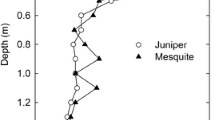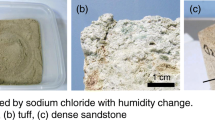Abstract
We have investigated how transport and accumulation of salt in a plaster depends on the underlying masonry material. To this end, moisture and sodium profiles have been measured non-destructively with a Nuclear Magnetic Resonance (NMR) technique during drying of plaster/substrate systems. The same plaster is applied on two substrates of which the pores are either an order of magnitude larger or smaller than those of the plaster. The moisture and salt transport and the salt accumulation differed significantly for these two systems. In a plaster/Bentheimer sandstone system (the pores of the plaster are smaller than those of the substrate) all salt is removed from the substrate and accumulates in the plaster. In a plaster/calcium-silicate brick system (the substrate has a considerable amount of pores that are smaller than those of the plaster) some salt crystallizes in the plaster layer, but a significant amount of salt remains within the substrate itself. The salt transport from substrate to plaster is quantified in terms of an efficiency number ɛ, which can be estimated from the pore-size distributions measured by mercury intrusion porosimetry.
Résumé
Nous avons étudié de quelle manière le transport et l’accumulation de sel dans du plâtre dépend du matériau de construction sous-jacent. Pour ce faire, les évolutions de l’humidité et de la teneur en sodium ont été mesurées de manière non destructrice à l’aide de la résonance magnétique nucléaire lors du séchage de systèmes plâtre/substrat. Un plâtre identique est appliqué sur deux substrats dont les pores sont un ordre de grandeur plus gros ou plus petits que ceux du plâtre. Le transport de l’humidité et du sel mais aussi l’accumulation du sel diffèrent de manière significative dans chacun de ces deux dispositifs. Dans un système plâtre/grès de Bentheimer (où les pores du plâtre sont plus petits que ceux du substrat), le sel a complètement disparu du substrat et se concentre dans le plâtre. Dans un système plâtre/brique de calcium-silicate (où le substrat possède un nombre significatif de pores qui sont plus petits que ceux du plâtre), une certaine fraction du sel cristallise dans la couche de plâtre mais la majeure partie demeure localisée au sein du substrat. Le transport du sel du substrat vers le plâtre est quantifié en termes d’efficacité ɛ. Celle-ci peut être estimée à partir de la distribution des pores suivant leur taille que l’on mesure grâce à de la porosimétrie par intrusion de mercure.
Similar content being viewed by others
References
Wijffels TJ, Groot CJWP, van Hees RPJ (1997) Performance of restoration plasters. 11th International Brick/Block Masonry Conference, Shanghai, China, pp␣1050–1062
Lubelli B, van Hees RPJ, Groot CJWP (2005) The performance of a restoration plaster in the field: investigation and monitoring of two case studies. International Workshop: repair mortars for historic masonry. Delft, The Netherlands
Goudie A, Viles H (1997) Salt weathering hazard. Wiley, Chichester
Dullien FAL (1991) Porous media: fluid transport and pore structure. Academic Press, London
Reinhardt HW, Gaber K (1990) From pore size distribution to equivalent pore size of cement mortar. Mater Struct 23:3–15
Nuame BK, Illston JM (1981) Relationships between permeability and pore structure of haredened cement pastes. Mag Concr Res 33:139–146
Mehta PK, Manmohan D (1980) Pore distribution and permeability of hardened cement pastes. 7th International Symposium of the Chemistry of Cement, Paris France
El Dieb AS, Hooton RD (1994) Evaluation of the Katz–Thomson model for estimating the water permeability of cement based materials from mercury intrusion porosimetry data. Cem Concr Res 24:443–455
Garboczi EJ (1990) Permeability, diffusivity and microstructural parameters: a critical rewiew. Cem Concr Res 20:591–601
Quenard DA, Xu K, Kuenzel HM, Bentz DP, Martys NS (1998) Microstructure and transport properties of porous building materials. Mater Struct 31:317–324
Bear J, Bachmat Y (1990) Introduction to modeling of transport phenomena in porous media, Vol 4. Kluwer, Dordrecht, The Netherlands
Robinson GC (1984) The relationship between pore structure and durability of brick. Bull Am Ceram Soc 63:295–300
Lubelli B, van Hees RPJ, Larbi J (2004) Influence of brick properties on salt crystalization damage. 6th International symposium on the conservation of monuments in the Mediteranean basin, Lisbon, Portugal, pp 283–288
Rossi-Manaresi R, Tucci A (1991) Pore structure and the disruptive or cementing effect of salt crystallization in various types of stone. Stud Conserv 36:56–58
WTA Merkblatt 2–2-91 (1992) Sanierputzsysteme, Wissenschaftlich technischen Arbeitsgemeinschaft für Bauwerkserhaltung und Denkmalpflege
Brocken HJP, Pel L (1997) Moisture transport over the brick-mortar interface: water absorption and drying. 11th International Brick/Block Masonry Conference, Shanghai, China, pp 826–835
Brocken HJP (1998) Moisture transport in brick masonry: the grey area between bricks. PhD Thesis, Eindhoven University of Technology
van Brakel J (1980) Mass transfer in convective drying, ‘Advances in drying’, Vol 1. Hemisphere, Washington
Le Bray Y, Prat M (1999) Three dimensional pore network simulation of drying in capillary porous media. Int J Heat and Mass Trans 42:4207–4224
Pel L, Huinink HP, Kopinga K (2002) Ion transport and crystallization in inorganic building materials as studied by nuclear magnetic resonance. Appl Phys Lett 81:2893–2895
Kopinga K, Pel L (1994) One-dimensional scanning of moisture in porous materials with NMR. Rev Sci Instrum 65:3673–3681
Pel L (1995) Moisture Transport in Porous Building Materials. PhD Thesis, Eindhoven University of Technology
Pel L, Kopinga K, Kaasschieter EF (2000) Saline absorption in calcium-silicate brick observed by NMR scanning. J Phys D: Appl Phys 33:1380–1385
Callagan PT (1991) Principles of nuclear magnetic resonance microscopy. Clarendon Press, Oxford
Brownstein KR, Tarr CE (1979) Importance of classical diffusion in NMR studies of water in biological cells. Phys Rev A 19:2446–2452
Valckenborg RME, Pel L, Kopinga K (2001) NMR relaxation and diffusion measurements on iron (III) doped kaolin clay. J Magn Res 151:291–297
Pel L, Huinink HP, Kopinga K (2003) Salt transport and crystallization in porous building materials. Magn Reson Imaging 21:317–320
Hall C, Hoff WD (2002) Water transport in brick, stone and concrete. Spon, London
Daïan JF (2002) Coupled salt and moisture transport in partially saturated porous media, in Poromechanics II Proceedings of the second Biot Conference on Poromechanics. Grenoble, France, pp 407–412
Nijland T (2004) Private communication
Rijniers LA (2004) Salt crystallization in porous materials: an NMR study. PhD Thesis, Eindhoven University of Technology
Mills R, Lobo VMM (1989) Self diffusion in electrolyte solutions in ‘Physical Sciences Data’, Vol 36. Elsevier
Pel L, Huinink HP, Kopinga K, van Hees RPJ, Adan OCG (2004) Efflorescence pathway diagram: understanding salt weathering. Constr Build Mater 18:309–313
Acknowledgements
Part of this research was supported by the Dutch Technology Foundation (STW), the Priority Program Materials Research (PPM), the Center for Building and Systems TNO-TUE, and the EU Directorate General Research
Author information
Authors and Affiliations
Corresponding author
Rights and permissions
About this article
Cite this article
Petković, J., Huinink, H.P., Pel, L. et al. Salt transport in plaster/substrate layers. Mater Struct 40, 475–490 (2007). https://doi.org/10.1617/s11527-006-9151-7
Received:
Accepted:
Published:
Issue Date:
DOI: https://doi.org/10.1617/s11527-006-9151-7




